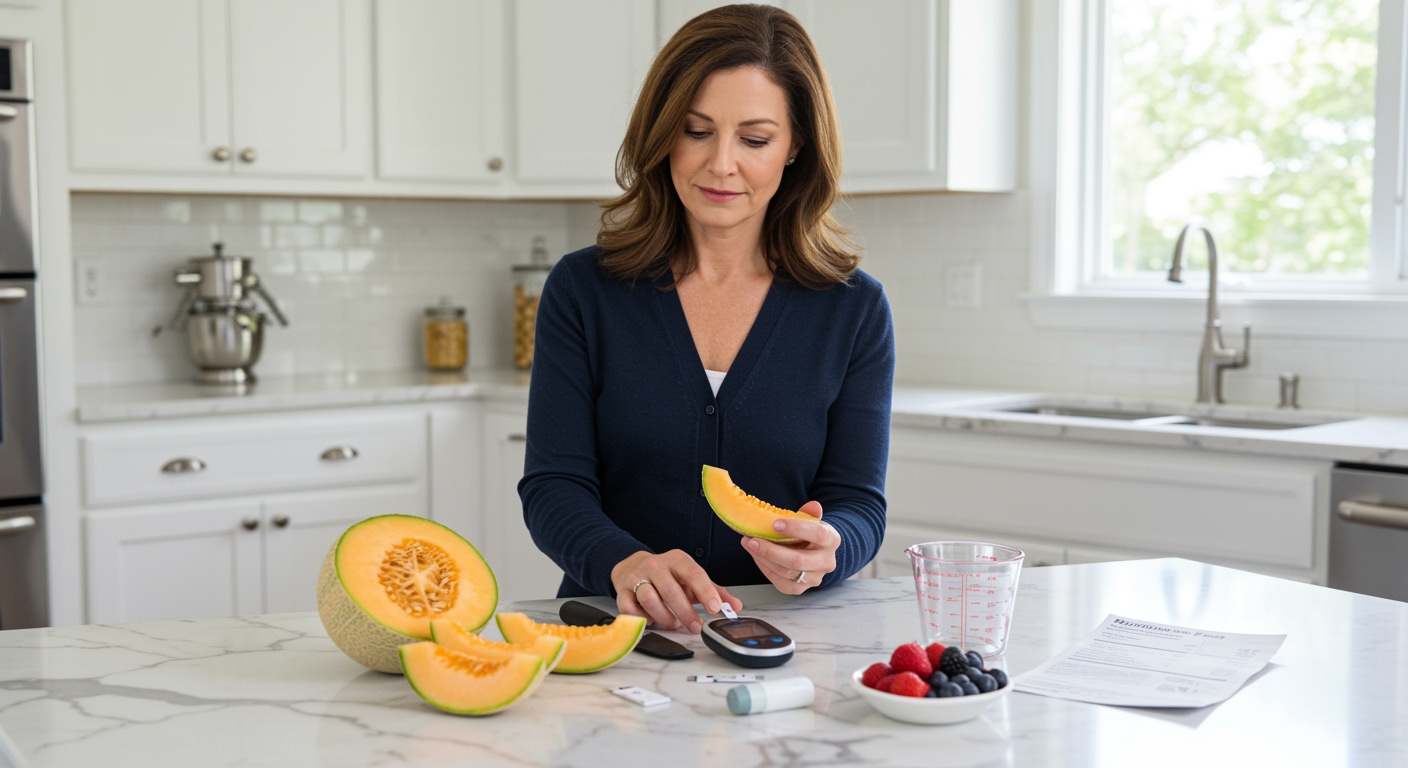✪ Key Takeaway: Cantaloupe is safe for diabetes when eaten in small portions due to its moderate glycemic index of 65.
Introduction
You stare at the sweet, orange cantaloupe in your kitchen and wonder if this juicy fruit will send your blood sugar through the roof.
Many people with diabetes avoid cantaloupe completely because they think all sweet fruits are dangerous for blood sugar control.
Hi, I’m Abdur, your nutrition coach and today I’m going to explain exactly how cantaloupe affects your blood sugar and whether you can safely include it in your diabetes meal plan.
What happens to your blood sugar when you eat cantaloupe?
Cantaloupe has a glycemic index of 65, which places it in the medium range on the glycemic scale.
This means cantaloupe will raise your blood sugar at a moderate pace compared to high-glycemic foods like white bread or candy.
The glycemic load of cantaloupe tells a different story though.
A typical serving of cantaloupe has a glycemic load of only 4, which is considered very low.
This happens because cantaloupe contains mostly water and fiber, with relatively small amounts of actual sugar per serving.
When you eat cantaloupe, the natural sugars get absorbed into your bloodstream through your small intestine.
Your pancreas responds by releasing insulin to help move this sugar into your cells for energy or storage.
✪ Pro Tip: Always pair cantaloupe with protein or healthy fats to slow sugar absorption and minimize blood sugar spikes.
How much cantaloupe can you safely eat with diabetes?
The key to eating cantaloupe with diabetes lies in portion control and timing.
A safe serving size is about one cup of cubed cantaloupe, which contains approximately 13 grams of carbohydrates.
This amount fits comfortably within most diabetes meal plans without causing dangerous blood sugar spikes.
Your individual carbohydrate tolerance will determine exactly how much cantaloupe you can handle.
Some people with well-controlled diabetes can eat slightly larger portions, while others need to stick to smaller amounts.
The best time to eat cantaloupe is during or after a balanced meal that includes protein and healthy fats.
This combination slows down sugar absorption and prevents rapid blood glucose increases.
✪ Fact: One cup of cantaloupe provides 100% of your daily vitamin C needs while containing only 54 calories.
Does cantaloupe provide any benefits for people with diabetes?
Cantaloupe offers several important health benefits that make it valuable for diabetes management.
This fruit contains high levels of vitamin C, which helps reduce inflammation and supports immune function.
People with diabetes often have higher levels of oxidative stress, and vitamin C acts as a powerful antioxidant to combat this damage.
Cantaloupe also provides potassium, an essential mineral that helps regulate blood pressure.
Many people with diabetes also struggle with high blood pressure, making potassium intake particularly important.
The fiber content in cantaloupe, while modest, still contributes to better digestive health and more stable blood sugar levels.
Beta-carotene in cantaloupe converts to vitamin A in your body, supporting eye health and potentially reducing the risk of diabetic retinopathy.
✪ Note: Choose cantaloupe with a sweet aroma and slight give when pressed at the stem end for optimal ripeness and flavor.
What should you avoid when eating cantaloupe with diabetes?
Several common mistakes can turn cantaloupe from a safe fruit into a blood sugar problem.
Never eat cantaloupe on an empty stomach, especially first thing in the morning when your blood sugar is already unstable.
Avoid eating large portions of cantaloupe in one sitting, even if it seems harmless because of its high water content.
Skip cantaloupe juice or smoothies that concentrate the fruit without the fiber benefits of whole fruit.
Liquid forms of fruit get absorbed much faster and can cause rapid blood sugar spikes.
Don’t combine cantaloupe with other high-glycemic foods like white rice, bread, or processed snacks.
This combination can overwhelm your body’s ability to manage blood sugar effectively.
✪ Pro Tip: Monitor your blood sugar 2 hours after eating cantaloupe to understand your personal response pattern.
How does cantaloupe compare to other fruits for diabetes?
Cantaloupe sits in the middle range when compared to other fruits commonly eaten by people with diabetes.
Berries like blueberries, strawberries, and raspberries have lower glycemic indexes and are generally safer choices for blood sugar control.
Apples and pears also rank lower on the glycemic scale and provide more fiber per serving than cantaloupe.
However, cantaloupe is much better than high-glycemic fruits like watermelon, pineapple, or ripe bananas.
The key difference lies in how quickly each fruit releases sugar into your bloodstream.
Cantaloupe provides a good balance of nutritional benefits without being too problematic for blood sugar management.
You can safely include cantaloupe in your diabetes meal plan as long as you follow proper portion sizes and timing guidelines.
✪ Fact: Cantaloupe contains 90% water, making it naturally lower in concentrated sugars than many other fruits.
The Bottom Line
Cantaloupe can be a safe and nutritious addition to your diabetes meal plan when eaten in appropriate portions and combined with other foods.
The secret to managing diabetes is not avoiding all sweet foods, but learning how to include them wisely in your overall eating pattern.
I would love to hear about your experience with cantaloupe and blood sugar management, so please share your questions, thoughts, or personal stories in the comments below.
At NutritionCrown, we use quality and credible sources to ensure our content is accurate and trustworthy. Below are the sources referenced in creating this article:
- Tristate Clinics: Cantaloupe and Blood Sugar: Essential Information for Diabetics
- Mayo Clinic: Low-glycemic index diet
- Signos: Cantaloupe Glycemic Index
- January AI: Cantaloupe Glycemic Index





